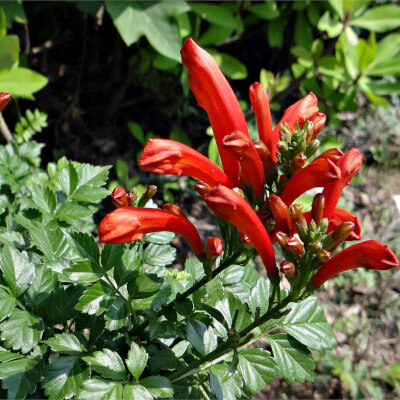
Tecoma capensis, commonly known as Cape Honeysuckle, is a climbing shrub native to southern Africa. This plant, highly valued for its spectacular flowering, is characterised by clusters of bright orange, tubular blossoms that attract birds and pollinating insects throughout the year. Under ideal conditions, it can grow up to three metres tall, making it a striking ornamental feature in botanical gardens. Its rapid growth makes it an excellent choice for covering fences, pergolas, or unsightly walls, while adding a tropical touch to the landscape.
In the Au Bois Vert botanical garden in Ivato, near Antananarivo, Cape Honeysuckle blends harmoniously with both native and exotic species, creating a vibrant setting that reflects the richness of biodiversity. This evergreen shrub thrives in warm, sunny climates but can also withstand periods of drought once well established. Visitors to the garden will not only appreciate its beauty but also its resilience against pests and its low maintenance requirements, making it an ideal plant for gardening enthusiasts with little horticultural experience.
Beyond its ornamental appeal, Tecoma capensis or Cape Honeysuckle plays an important role in supporting local biodiversity by attracting nectar-feeding species such as hummingbirds. This ecological function, combined with its remarkable adaptability, makes it a valuable addition to any sustainable gardening project. At Hotel Au Bois Vert, it is a key feature of the green spaces, adding a colourful and welcoming touch that delights visitors to the restaurant and lodge alike.
Plant use
Tecoma capensis is a versatile plant, valued both for its ornamental appeal and its practical functions in landscaping. In the Au Bois Vert botanical garden, this species is used as a natural hedge or a green screen, thanks to its dense growth and climbing ability. It is also commonly employed to combat soil erosion in sloped areas. Its evergreen foliage and prolonged flowering period ensure a lush and colourful appearance throughout the year, even during the driest seasons. In urban settings, Tecoma capensis is a popular choice for public green spaces, parks, and private gardens, particularly in Antananarivo and its surroundings. Its low-maintenance nature makes it an ideal plant for hotels, lodges, and restaurants looking to enhance their outdoor spaces while minimising upkeep efforts. The botanical garden in Ivato showcases this plant in various landscape compositions, demonstrating its compatibility with other tropical and subtropical species. Furthermore, in some regions of Southern Africa, infusions made from its leaves have been used in traditional medicine to relieve abdominal pain or treat mild respiratory issues. Although this usage is not scientifically validated, it highlights the cultural significance of Tecoma capensis. This plant therefore represents a perfect blend of aesthetics, practicality, and tradition.
Key information
| Common name | Cape Honeysuckle |
| Scientific name | Tecoma capensis |
| Origin | Southern Africa |
| Natural habitat | Subtropical regions and dry areas |
| Life cycle | Perennial, evergreen shrub |
| Flowering period | All year round, with a peak in spring and autumn |


